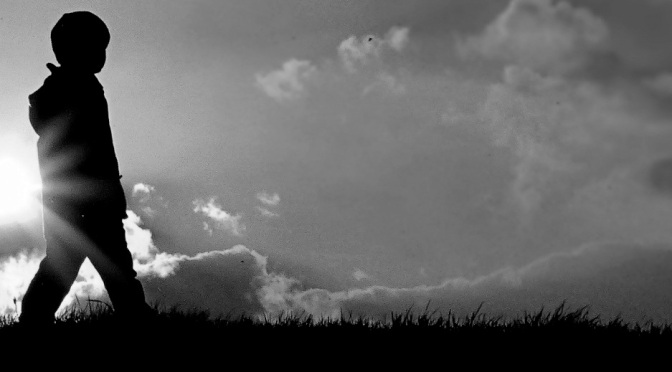.
.
Roberto seems aloof, sometimes labelled as disrespectful.
Underneath that “tip of the iceberg”is a person. A person with a story.
Roberto’s mother abandoned him, as an infant.
Then he was ‘placed’ into foster care with strangers.
Later he re-united with his father, but soon afterwards Daddy was imprisoned.
Roberto moved in with Grandpop. Grandpop was ill, terminally ill and on house arrest. And angry. Roberto was scared and essentially on “house arrest” too, except for school.
Three+ childhood traumas.
During school Roberto often refused to sit at a desk. He slowly, calmly walked our classroom perimeter, stopping to stare silently out our windows. Other times he quietly put his head down on his desk. Either way, he ignored all efforts to communicate.
Roberto was not normally aggressive or hostile; sometimes, he simply, silently walked out.
The signs are easy to miss completely in classroom settings. Roberto’s behaviors are not distracting. Even when recognized, they are tempting to ignore in favor of focussing on peers with different, disruptive aggression. Yet, Roberto is every bit as injured and hurting.
This is beyond momentary daydreaming: extended, vacant staring, no empathy, no emotion. Robotic. Social interaction is rare.
In large groups or unstructured settings, like lunch and recess, Roberto did occasionally get vicious in his frustration, after losing patience with pushy peers. Those were rare exceptions.
.
Back in the classroom, although a bright boy, Roberto usually didn’t know what we were learning about and often had no sense of time.
Roberto defends his current self by separating from his memories of himself — past experiences of neglect, intense fear, and abuse. He’s perfected “emotional numbing”. It’s called “dissociation”.
Splitting off parts of one’s own mind from consciousness, “dissociation”, is sometimes termed a disorder, but it is a logical, common, neurobiological defense after developmental trauma. A very different defense than “hyperarousal.“
Meanwhile, the toxic, childhood stress is changing the physical architecture of Roberto’s brain.
Whether abuse, family dysfunction or neglect, trauma impacts 2 out of 3 kids at some level. Experts call it “epidemic.”
Trauma-Informed adults CAN make a difference.
Get Informed. Click on links below.
.
Informed already? Then, please “share” the blog post. Help grow awareness of this secret epidemic destroying childhoods.
.
.
.
Dissociation FAQs: International Society for the Study of Trauma and Dissociation Click HERE
.
National Child Traumatic Stress Network; Trauma Defenses CLICK HERE
.
Understanding the Behavioral and Emotional Consequences of Child Abuse CLICK HERE
.
Toxic Stress changes brain architecture CLICK HERE (2 minute video)
.
.
.
.
.
Look for other parts of this series “Nowhere to Hide” on LucidWitness.com for more information.
.
“Nowhere to Hide” series overview
click HERE

“Nowhere to Hide” series links
Each separate, individual article in the series focuses on a single component of the workings of developmental trauma, via real life examples in short “60 second” soundbites, akin to “Public Service Announcements” (PSAs). They are designed for sharing in social media networks to grow public awareness.
Trigger warning:
The children’s experiences in the vignettes are unvarnished. Their traumatic responses may trigger painful memories.
.
“PSA” Links for social media
.
Nowhere to Hide: Maria; Fight, flight or freeze

Nowhere to Hide: Andre’s Fear; What are Adverse Childhood Experiences?

Nowhere to Hide: Jamar’s Hyper-arousal

Nowhere to Hide: Roberto’s Dissociation

Nowhere to Hide: Danny’s Memory

Nowhere to Hide: Ashley’s “Normal” Education? Part 1

Nowhere to Hide: Ashley’s “Normal” Education? Part 2

More to come
.
“Like” us at “Trauma-Informed Pedagogy” on Facebook
.
Please share a PSA link to help grow public awareness of the impacts of developmental trauma. There are so many of us who’ve never heard of the overpowering life-long impacts.
.
“Peek Inside a Classroom” series overview
The second original series, “Peek Inside a Classroom”, provides much more detailed looks inside my classroom, primarily focused on specific students: Jasmine, Danny and José.
Other children are captured in broader looks at education reform concepts: “Failing Schools or Failing Paradigm?” and “Effective Education Reform”, co-authored with Sandra L. Bloom, M. D..
.
“Peek Inside a Classroom” series links
.
Peek Inside a Classroom: Jasmine

Peek Inside a Classroom: Danny


Peek Inside a Classroom: Failing Schools or Failing Paradigm?
Peek Inside a Classroom: Effective Education Reform (with Sandra Bloom, M.D.)
.
“Click for Resources…” series overview:
“Click for Resources” posts are the theory and research behind the narrative posts in “Nowhere to Hide” and “Peek Inside a Classroom”.
Each post in “Click for Resources “ is divided in three parts:
1) general press articles,
2) Research Journals or academic papers
3) social media, often with video.
.
“Click for Resources” series links:
.
1. Adverse Childhood Experience (ACE) Studies: CLICK HERE
2. Impacts of Childhood Trauma: Overview CLICK HERE
Click for Resources: Social Media on Impacts of Childhood Trauma
Click for Resources: Journal Articles on Impacts of Developmental Trauma
3. Trauma-Informed Schools CLICK HERE

4. Trauma-Informed Social Services CLICK HERE

5. Trauma-Informed Juvenile Justice CLICK HERE

6. Trauma-Informed Public Policy CLICK HERE

7. Childhood Trauma Training and Tools CLICK HERE

8. Book and Publication selections CLICK HERE

9. #800 phone numbers CLICK HERE

Developmental trauma, still “the elephant in the [class] room” for many adults.
.
“Like” us at “Trauma-Informed Pedagogy” on Facebook
.








